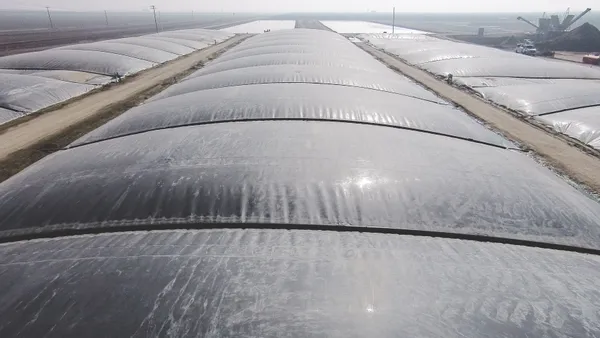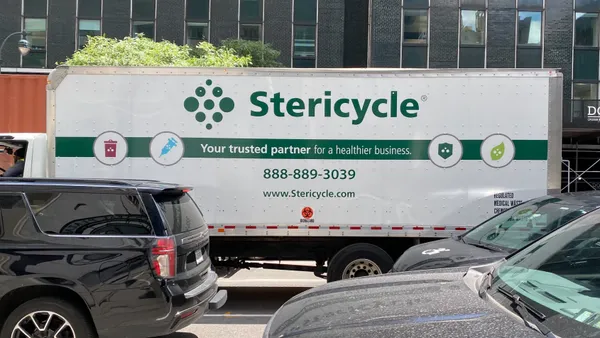Dive Brief:
- Austin Resource Recovery (ARR) is slated to begin the fourth and final expansion of its curbside composting program this month, bringing the total number of Austin, Texas, residents with access to the organics diversion service to over 200,000 households.
- The city began introducing curbside composting for all organics in 2017 along existing yard waste pickup routes. Start dates for the 55,000 single-family homes being added in this round will be split between the weeks of Feb. 8 and Feb. 15.
- An August 2018 audit indicated an approximately 30% program participation rate. It's hard to say how much the city has improved on overall landfill diversion goals as the program has expanded; when the diversion rate was last measured in 2015, it stood at 42%. But the city has diverted about 91,000 tons of compostable material from landfills via the program, which is sent to Organics By Gosh for processing.
Dive Insight:
As growing urban hubs target ambitious zero waste goals — Austin's being to divert 90% of materials from landfills by 2040 — increased participation in composting is seen as a critical piece of the puzzle.
The city's commitment to its zero waste goal is part of what pushed ARR to see the expansion through to completion during the pandemic, said Ken Snipes, who formerly served as director of solid waste for Seattle Public Utilities and took over Austin's agency midway through its curbside composting expansion in late 2019.
Seattle is home to a curbside composting program for homes and businesses, as are other major cities like San Francisco. Snipes said the questions he and his team get from other municipalities exploring curbside composting programs of their own center around how to secure support from elected officials and the public.
Still, spokesperson Ashley Pace acknowledged that it's easier to extend a program at this time than start one anew. "It might be a different story if we were considering starting a program at this time, but because it's already three quarters of the way through, I think that made it a higher priority to add the remaining customers," she said.
New York City and Cambridge, Massachusetts, are examples of cities where curbside organics collection efforts have been thwarted by budget cuts and disruptive safety measures during the pandemic. Although Austin is moving forward with the curbside composting expansion, it was supposed to have happened in 2020, and other ARR services have been changed or paused due to staffing issues and other challenges during COVID-19.
A new analysis from national nonprofit ReFED supports Austin's emphasis on residential composting, noting the residential sector remains the greatest overall source of food waste. ReFED estimates an annual investment of $14 billion over the next decade on prevention, rescue and recycling efforts could cut 45 million tons of food waste a year.
ReFED's data released this week suggest efforts to curb food waste in recent years are contributing to some improvement. Food waste volumes in the U.S. appear to have leveled off at the end of last decade, after rising 11.9% in the earlier half. Still, 35% of food reportedly was uneaten or unsold in the U.S. in 2019.
Infrastructure remains an area for improvement across the board, according to discourse at last week's U.S. Composting Council annual conference, but there were examples of momentum via local government pilot programs and increasing use of private subscription pickup services.
Each leg of expansion has brought its own lessons, Pace said. Initially in 2017, ARR outfitted households with 96-gallon carts for composting, before learning that a smaller 32-gallon cart was a more appropriate size for most customers. In 2018, ARR introduced compostable bags, hoping to quell customer concerns about odor who were seeking to “avoid the ick.” In those two initial years ARR distributed educational resources when carts were delivered to homes, but switched to mailing information for new users.
ARR made a messaging push in 2019 highlighting to customers that they had the potential to save hundreds of dollars on their overall utility bill by recycling and composting more materials and thereby downsizing the size of their trash cart. “Our carts division who exchanges cart sizes was overwhelmed at first,” Pace said.
ARR did not go full throttle on messaging campaigns in past years, however, as not all customers had access to the program. That means there's work yet to be done.
“I think our education work is never-ending. I mean we're constantly trying to figure out better ways to connect with the customer to help them understand the benefits of the program," Snipes said. "I think the biggest hurdle for us going forward is just increase our participation rates and set-out rates for this material."
Other initiatives going on at ARR include updating its comprehensive plan for hitting zero waste goals. The existing version of that plan was published in 2011. It's also exploring electrification of small vehicles in its fleet, but has yet to electrify collection trucks, citing operational mileage limitations.











